Triple top pattern: Definition, Importance, Parts, How It Works, Benefits, Risks, and What Does It Tell?
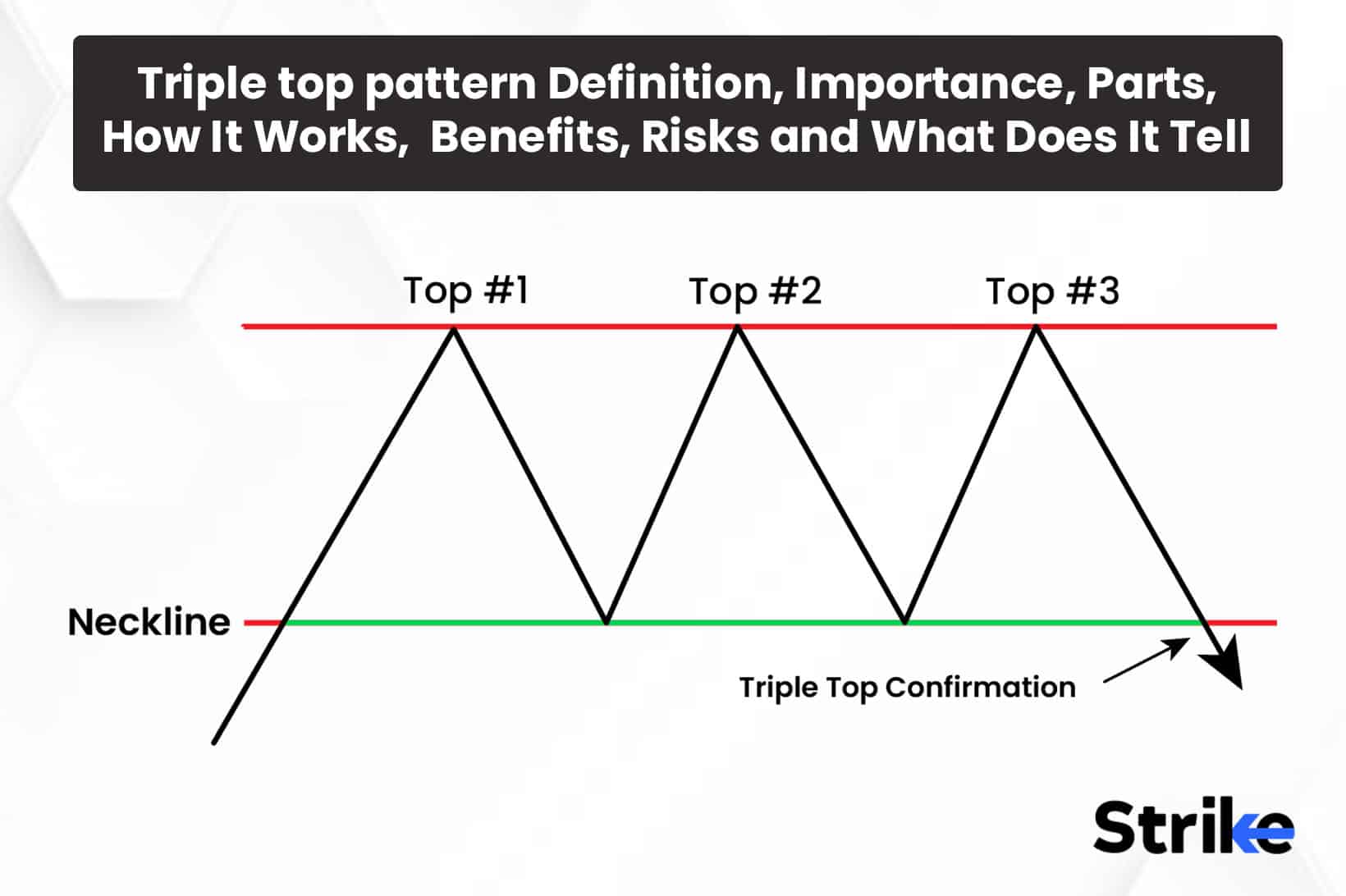
The triple top pattern is a reversal formation that technical analysts use to identify potential trend changes on financial charts. The triple top pattern consists of three peaks or tops that are formed around the same price level, with troughs or pullbacks in between. This distinctive three-peak shape signals that upside momentum may be waning as resistance from sellers strengthens.
As the name implies, the defining characteristic of a triple top is the three attempts by prices to rise above a certain resistance level. Each peak is usually slightly lower than the last as buyer enthusiasm diminishes. The volume also tends to decrease with each successive rally attempt. If, after the third effort, prices are unable to punch through resistance and instead break below a supportive floor, it confirms the pattern and indicates an uptrend may be nearing its end.
Traders aim to capitalize on triple top breakdowns by shorting on the close below support or anticipating the break. Correct identification, combined with analysis of volume and other indicators, helps gauge the strength of ensuing downtrends. This reliable reversal formation provides clues on shifting market psychology and presents opportunities for technical players.
What is the Triple Top Pattern?
The triple top pattern is a reversal chart pattern that is formed when the price of security hits the same resistance level three times before breaking down. The triple top pattern is considered a bearish signal that indicates a shift in the market sentiment from bullish to bearish.
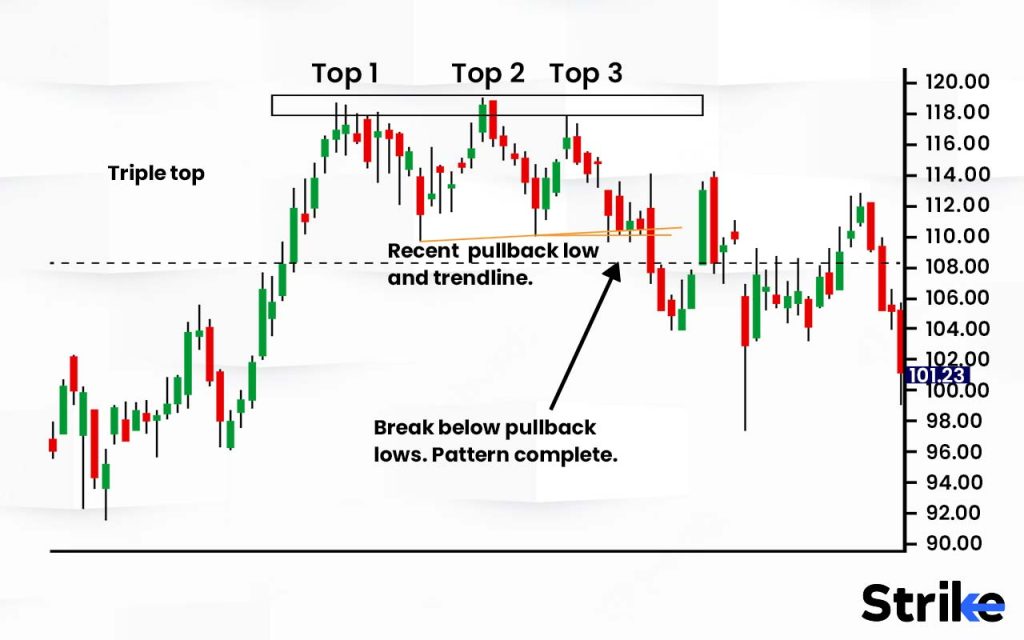
The formation of the triple top pattern begins when the price rises and hits a resistance level, retreats, and then returns to test the resistance again, forming the first two tops. After failing to break through the resistance for the second time, the price pulls back again before making one final attempt to break through the level. However, it is again rejected, and the price falls below the support level, completing the triple top pattern.
The three peaks are roughly equal in height and are spaced apart over some time. The time between the peaks ranges from a few weeks to several months. The volume pattern typically diminishes with each successive peak. The decreased volume shows waning buying pressure as the tops form. After the third peak, volume picks up as sellers take control and drive the price below support.
The break of support signals that demand has weakened and the balance has tipped from bullish to bearish sentiment. Sellers have gained control, and any buyers who enter the market are quickly overwhelmed by selling pressure. This new supply drives the price lower. The break of support validates the pattern and confirms the downtrend.
Six significant features distinguish the triple top pattern.
Three distinct peaks at roughly the same price level.
Peaks are spaced apart over time.
Diminishing volume on each successive peak.
The middle top forms a higher low compared to the first top.
The lows between peaks hold above support.
The pattern is completed with a break below support.
The size of the pattern varies depending on the timeframe and volatility of the security. On a daily chart, the tops are spaced weeks or months apart. On lower time frames like hourly or 15-minute charts, the tops form over just a few days. Larger patterns that form over longer time frames are considered more significant.
The depth of the retracements between tops also contributes to pattern validity. Shallow retracements maintain the horizontal support level and indicate solidifying resistance. Steeper corrections between tops show a willingness to buy on dips and invalidate the pattern. A valid triple top usually sees corrections less than 50% of the prior up move.
The triple top is similar to other reversal patterns like the head and shoulders or the triple bottom. The head and shoulders also have three peaks with a central higher peak. But tops form the horizontal resistance in a triple top rather than angled necklines. The triple bottom creates three troughs rather than peaks.
Used properly, the triple top alerts traders to a shift in the balance of power from bulls to bears. It represents a struggle between buyers and sellers in which the buyers finally capitulate, allowing the bears to take control. The pattern provides an early warning for this trend change. Combining pattern analysis with volume, price action and indicators gives traders an edge in determining when a reversal is imminent. The triple top remains a valuable tool for technical traders in spotting turns in the market.
How Does the Triple Top Pattern Work?
The triple top pattern works by forming when an asset hits the same resistance level three times without breaking above it, signalling a potential reversal of the uptrend. The triple top is a reversal chart pattern that signals a potential change from an uptrend to a downtrend. The following is a summary of the triple top pattern’s normal formation process and the crucial steps that lead to it.
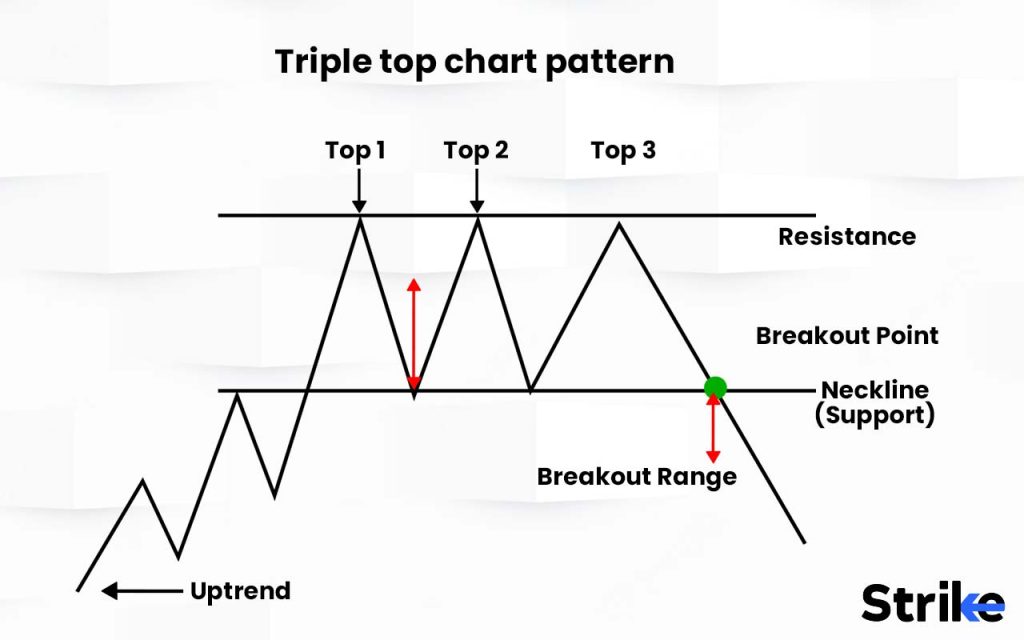
The triple top pattern begins with an established uptrend in place. This means the stock or asset has been steadily rising over weeks or months. The uptrend is identified by higher swing highs and higher swing lows in the price action.
As the uptrend advances, the price approaches a key resistance level and struggles to break above it. This results in the formation of the first peak in the pattern. Resistance could be a previous all-time high price, a key Fibonacci or moving average level, or a price zone where the stock has reversed multiple times before.
After hitting resistance, buyers are unable to sustain the uptrend. Profit-taking and selling pressure kicked in, causing the stock to retreat from the first peak. This establishes the first trough of the pattern. The pullback validates the area of resistance.
As the decline pauses, dip buyers and remaining bulls see the retreat as a buying opportunity. This propels the stock up to make another test of the resistance zone. The price rises towards but fails to eclipse the previous high peak, forming the second peak at a similar level.
Once again, the stock is pushed back from resistance as supply overwhelms demand. The price heads lower, marking the second trough in the pattern. This trough is typically at a lower level than the preceding one, reflecting weakened momentum.
After another pause and consolidation, the stock attempts one more rally to challenge resistance. Volume tends to decline on the rise to the third peak, indicating waning momentum. The price struggles to make headway and forms the third peak at or near the same level as the previous two tops.
The triple top pattern is completed when sellers take control and force the price decisively below nearby support around the troughs. This breakdown reflects failed demand and confirms the transition from an uptrend to a downtrend. A drop of 10% or more tends to signal a valid break.
Technical traders watch for increased selling volume on the breakdown for confirmation. The breakdown point under support becomes the new overhead resistance on any counter-trend bounces.
The psychology behind the pattern relates to shifting supply and demand dynamics. The repeated failed attempts to break resistance reflect the depletion of buying power. The three peaks show there is a significant supply available, limiting further upside.
Despite buyers’ efforts to absorb this supply and propel the price higher, the stock needs to gain upside traction. The fading momentum combined with triple failure finally convinces market participants the uptrend is over. This shift in market psychology facilitates the turnover from bullishness to bearishness.
Volume analysis provides clues as the pattern takes shape. The rising volume of moves up to resistance reflects enthusiasm. Declining volume on the pullbacks and the move up to the third peak hints at waning appetite. Finally, heavy selling volume signals conviction behind the breakdown.
The pattern reflects changing market psychology, and reversal signals prove profitable. However, like with any technical indicator, the triple top should not be used in isolation. Considering price action, momentum, volume, and other chart factors improves accuracy. Strict criteria around peaks, troughs and break levels help avoid false signals.
How Important is Triple Top for Technical Analysis?
The triple top is important for technical analysis because it signals a potential trend reversal and breakdown from an asset’s upside momentum, indicating a shift in market psychology and supply/demand dynamics. The pattern provides technicians with an early warning sign to change bias, adjust targets, or take profits accordingly before a sustained downward move.
Its implications are especially noteworthy when the triple top appears after a prolonged uptrend or at key technical analysis levels like all-time highs or round numbers, which act as mental barriers. Traders use the pattern to time entries for short positions, place stop-losses, and identify price objectives.
While not a definitive signal, a confirmed triple top gives technicians reason to adopt a bearish bias and anticipate further downside follow-through. Its popularity underscores the pattern’s perceived predictive value for market psychology and its role as a frequent contributor to investment decisions.
How Can you Identify a Triple Top Pattern on a Chart?
The triple top pattern is identified on a chart when an asset hits the same resistance level three times without being able to break above it. Typically, the asset will rise towards the resistance level, retreat, and then rise back up to test the level again twice more. Each peak reaches the same resistance zone before selling pressure pushes the price lower. See the picture below.
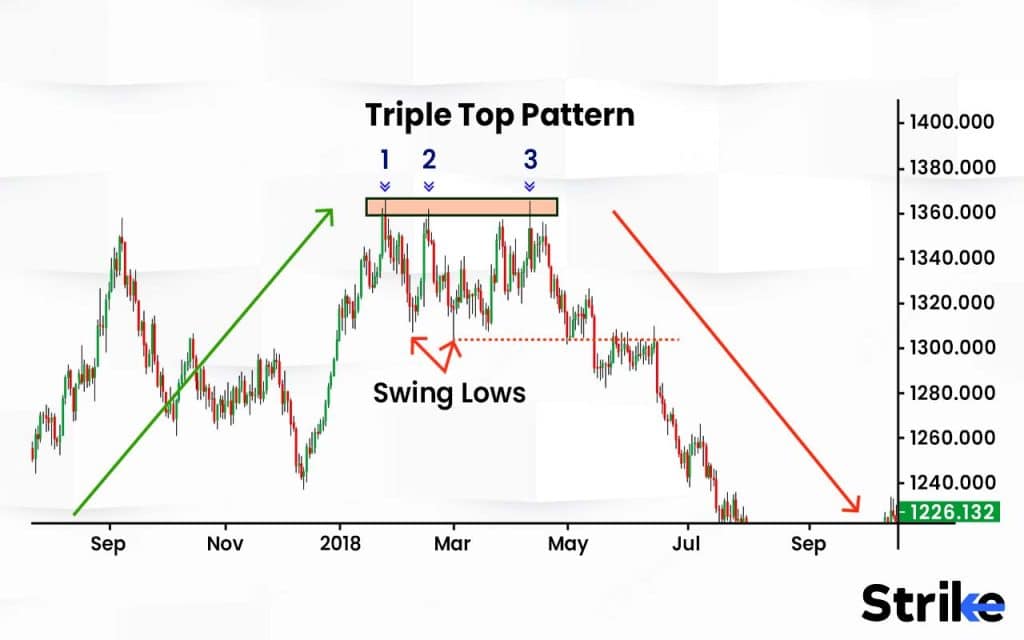
The three peaks should be roughly equal in height and spaced out somewhat equally. The valleys between the peaks do not need to fall to the same lows, but the uptrend is clearly losing momentum. Volume on each successive peak usually declines, showing waning buying interest at resistance. After the third peak fails to surpass resistance, sellers take control and push the asset downward, breaking the sequence of higher highs.
Technicians wait for a break of support before confirming the reversal. The breakdown point is sometimes the trough low between the second and third peaks. The projected target is equal to the triple top pattern height subtracted from the breakdown point. Traders watch for increasing volume on the breakdown for conviction. The pattern unfolds over weeks or months and requires patience to monitor the battle between buyers and sellers. When sellers prevail after three failed peaks, the triple top signals the uptrend may be over.
What are the Parts of a Triple Top Pattern?
There are eight parts for a triple top pattern—the first peak forms when the asset price reaches a resistance level, unable to break higher. After selling off, the first trough occurs, where the decline halts and buying resumes. This lifts the asset back up to the same resistance zone, forming the second peak around the same height before selling absorption.
The second trough follows as the asset drops again but finds support. With buying efforts renewed, the asset rallies back up but gets rejected at resistance for a third time, forming the final peak with diminishing volume.
With buyers exhausted after three failed peaks, the asset then breaks support, which confirms the triple-top reversal pattern. The three peaks rotating between resistance and trough supports reveal fading upside momentum and emerging downside conviction.
What are Potential Benefits of Triple Top Pattern Used as a Trading Decision?
The triple top pattern offers the following ten advantages when making trading decisions, including early warning signals, high probability setup, etc.
1.Early warning signal
The evolving triple top provides an early alert that buying pressure is waning and a potential trend change is ahead. Traders prepare for reversals in advance rather than reacting after the fact.
2. High probability setup
Statistical analysis shows the triple top often resolves in the expected direction after support breaks. This high probability of success improves trading edge and profit potential.
3. Favourable risk-reward
Entry near support with stops above the triple-top peaks provides a defined risk point. Profit targets are open below support, providing a favourable risk-reward scenario.
4. Prevents overtrading
The pattern provides an objective context for executing or avoiding trades. Traders wait for specific setups rather than overtrading without a plan. This improves the win rate.
5. Volume confirmation
Shrinking volume on each peak and increased volume on the breakdown improves pattern validity. Combining volume analysis with the pattern provides greater confidence.
6. Objective entry/exit points
The clear support/resistance levels give objective rules for entering and exiting trades rather than relying on discretion. Pattern trades have defined parameters.
7. Universal application
The triple top generalizes across diverse markets and timeframes. Traders apply the edge to virtually any tradable instrument, from stocks to forex and commodities.
8. Accountability
Following exact pattern rules demands trading discipline and accountability. Traders must stick to high-probability setups and manage trades according to a plan.
9. Flexibility
Beyond just entering shorts, the pattern allows flexibility using options, hedges, throwback entries, etc. Traders adapt strategies to suit their style.
10. Loss management
The defined support/resistance zones make it easy to place logical stops. This helps manage trading losses according to pre-planned risk parameters.
Utilizing the triple top pattern provides objective, high-probability trading opportunities with defined risk. Combining pattern analysis with prudent risk management practices enhances overall trading performance. It exemplifies using probability theory and technicals to identify favourable trade setups.
What are Risks of Triple Top Pattern Used as a Trading Decision?
These ten possible risks should be taken into account when employing the triple top pattern as part of a trading decision.
1.False breakdowns
Sometimes, support breaks briefly before the price recovers back above it. This false breakdown invalidates the pattern and leads to losing trades.
2. Premature entries
Entering short trades too early before confirmation of the breakdown increases the risk of failure. Patience is required.
3. Invalidation
The pattern is sometimes negated if resistance breaks to the upside. Traders must quickly exit losing trades on pattern failures.
4. Late reactions
Lagging indicators or oscillators are slow to reflect the trend change implied by the pattern, causing late reactions.
5. Range bound markets
Triple tops are best suited to trending markets. Range-bound conditions result in repeated failures and stops being triggered.
6. Subjectivity
Pattern identification relies on individual interpretation. Traders must use caution to avoid seeing patterns that aren’t there.
7. Clustering tops
Multiple minor peaks around the same level make it hard to discern the exact significant tops to trade from.
8. Lack of confirmation
The pattern should ideally align with other technical indicators to confirm the reversal for higher probability.
9. Anticipation trading
Entering on the second top expecting breakdown leads to a higher risk of failure than waiting for confirmation.
10. Loss of support
The risk is increased if there are security holes below the point of support after a breakdown.
The triple top pattern contains risks like any technical trading method. Careful pattern analysis, risk management, confirmation, and avoidance of anticipation are required to mitigate these risks. Using the setup objectively within a structured trading plan improves the probability of success. No pattern is perfect, but combining the triple top with prudent analysis enhances trading performance.
What Do Trip Top Patterns Tell You?
The triple top patterns tell traders that upside momentum is fading and the bulls are losing control. The pattern signals potential exhaustion after an uptrend, indicating a shift in the supply/demand dynamics. Each successive peak demonstrates the bulls have diminishing power to break major resistance.
Meanwhile, the bears gain strength as selling pressure intensifies after each peak. The flipping between buying enthusiasm and selling absorption reflects changing market psychology. Triple tops convey that buyers who were eager to chase new highs are becoming more cautious of further gains. With distribution underway, the market tone tilts from greed and euphoria to anxiety and scepticism.
For technicians, the pattern provides an early warning before the trend officially reverses. The triple top telegraphs that risk/reward is skewing to the downside, and key resistance may hold. Heeding this can allow traders to take defensive actions ahead of the bearish breakdown.
When to Place a Stop Loss for Triple Top Pattern?
The right place to place a stop loss for a triple top pattern is above the high of the third peak. This allows the pattern to play out fully and for the breakdown to be confirmed before getting stopped out of a short position.
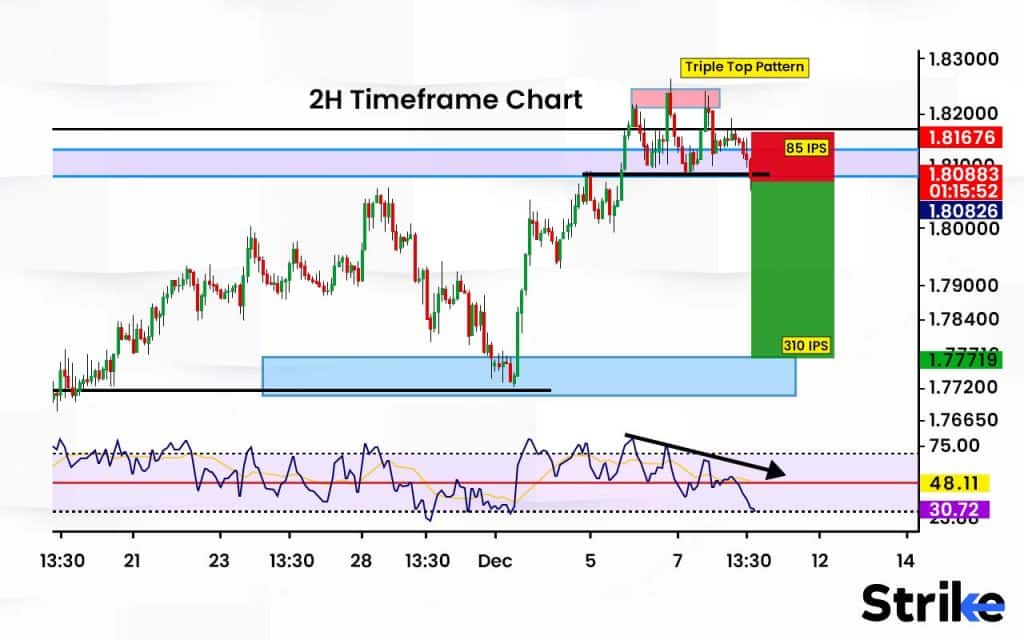
Specifically, traders will look to initiate a short trade once the asset price breaches support after the third peak. This breakdown signals sellers have overwhelmed buyers, and the uptrend is reversing. The stop loss should then be placed just above the high of the third peak, which also marks the resistance zone the asset failed to overcome three times.
Placing the stop above this high allows for some wiggle room in case the asset retests resistance before heading lower. Having the stop triggered above resistance invalidates the pattern breakdown. The stop loss gives the pattern room to unfold while limiting risk. The target profit is set near the level of the troughs or further if the asset begins collapsing rapidly after the breakdown.
Keeping the stop loss above the third peak high lets traders hold shorts confidently as the breakdown accelerates. Only a renewed close above resistance would warrant an exit. This approach mirrors the pattern psychology of buyers making three failed attempts before sellers take over. Tying the stop loss to key technical levels confirms whether the pattern is genuine and reduces the likelihood of getting stopped prematurely.
How To Trade the Triple Top Pattern?
To trade the triple top pattern, traders wait for the breakdown of support after the third peak to initiate short positions. Specifically, the breakdown point is often around the troughs formed between the peaks. Traders verify the pattern once the asset price closes below this support level following the third unsuccessful test of resistance.
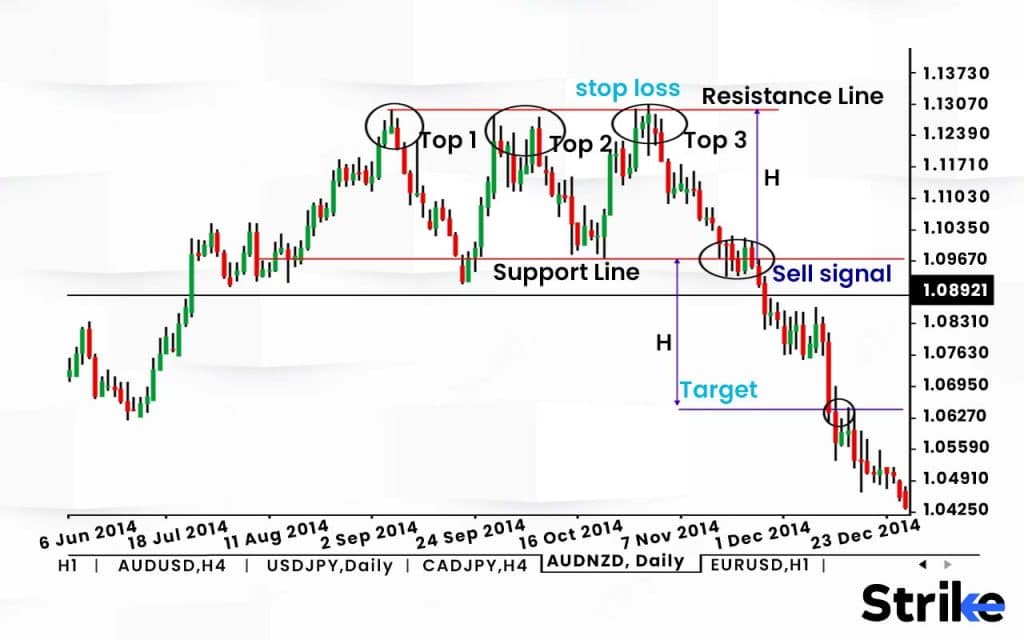
The stop loss is then placed above the third peak’s high to give the pattern room for follow-through. The profit target can be set near the level of the troughs or lower if the asset begins collapsing rapidly after the breakdown. Short positions are held with confidence as long as the price remains below resistance.
Patience is required when trading triple tops as the pattern unfolds over weeks or months. Traders bide time as the asset hits resistance and retreats twice before the third peak and subsequent breakdown. It’s best to wait for confirmation before taking trades based solely on projecting the pattern completion.
How Does Triple Top Pattern Indicate a Trend Reversal?
Triple Top Pattern indicates a trend reversal by signalling that upside momentum is fizzling out, and buyers are losing conviction after multiple failed attempts to break resistance. The pattern typically forms after a sustained uptrend or long bull run, marking an inflexion point where supply begins overtaking demand.
The inability to reach new highs after three peaks shows buyers are losing enthusiasm and face exhaustion. The push above resistance on initial optimism gets rejected on reduced volumes subsequently as scepticism sets in. Sellers capitalize on this loss of momentum by aggressively offloading around resistance. With distribution ramping up, the market balance tilts from greed, complacency and euphoria to anxiety, indifference and distribution.
The flipping psychology is encapsulated in the triple top alternating between hope-fueled peaks and discouraged sell-offs. Once the third peak forms, sellers take decisive control as buyers become unwilling to chase new heights. This translates to a breakdown of support and confirmation of the trend reversal.
The triple top mirrors the maturation of a bull market when risks emerge, and further gains become challenging. Its bearish implications are most stark after a long uptrend, signalling the cyclical peaking of positive sentiment. For traders, the pattern highlights that the prudent action is to turn cautious and implement defensive strategies before the selling intensifies further.
Is Triple Top Pattern Originated by Three Peaks Advancing into the Same Region with Pullbacks in Between?
Yes, the triple top pattern originated and is defined by three peaks advancing into the same price region with pullbacks in between each peak. The formation of the pattern begins with an uptrend, as buyers push the price higher into a region of resistance. The first peak forms when the price hits that overhead resistance level and gets rejected down off of it.
Do Traders Exit Longs or Enters Shorts when the Triple Top Completes?
No, traders do not automatically exit longs or enter shorts when the triple top pattern completes. The completion of a triple top pattern does not necessarily mean traders should immediately close out long positions or initiate new short positions. Instead, the proper trading response depends on how the pattern breaks out – whether the price breaks above resistance or falls below support.
Are There Any Real-World Examples of Successful Triple Top Pattern Trades?
Yes, there are many real-world examples of traders successfully capitalizing on the triple-top pattern. In 2016, gold prices formed a long-term triple top over 18 months. It made three peaked attempts between Rs. 1350-Rs. 1375 while in a broader uptrend. But after the third test failed, gold broke support around Rs. 1250, completing the pattern. Astute traders like Paul Tudor Jones executed short positions on the breakdown for large gains as gold declined over Rs. 200 in the following months.
Can I Combine Triple Top Pattern with Other Technical Chart Patterns?
Yes, the triple top pattern is combined with other chart patterns to improve trading results. Using the triple top in conjunction with other patterns helps confirm both the direction and strength of potential breakouts. For example, adding volume analysis to a triple top shows if momentum is building on the breakout. High volume on the upside breakout adds confidence it will continue rising.
What is the Difference between Triple Top Pattern from Triple Bottom Pattern?
The main difference between Triple Top Pattern and Triple Bottom Pattern is that the triple top signals a potential reversal of an uptrend to a downtrend, while the triple bottom signals the opposite – a potential reversal from a downtrend to an uptrend.
In a triple-top pattern, the price hits the same resistance level three times, forming a series of peaks that show buyers unable to break higher. This indicates waning bullish momentum. In contrast, the triple bottom pattern forms three troughs at the same support level as buyers emerge and propel the bounces off the lows. This shows gathering bullish strength.
The triple top represents exhausted buyers who repeatedly get rejected at resistance while sellers distribution accelerates. The triple bottom reflects sellers getting overwhelmed by renewed buyer interest and demand absorbing supply after multiple lows. The difference in psychology is notable. With the triple top, optimism fades, risks emerge, and gains become elusive, necessitating a defensive approach. The triple bottom elicits bargain hunting, improved sentiment, and buyers anticipating a rally, supporting an aggressive stance.
Traders thus interpret the patterns differently. The triple top signals an impending breakdown and need to go short—the triple bottom prompts positioning for an upside breakout by going long. The patterns look similar but have opposite implications due to what buyers and sellers are doing around key zones. Analyzing this market behaviour and psychology is key to trading the chart patterns.





 Previous Article
Previous Article






No Comments Yet